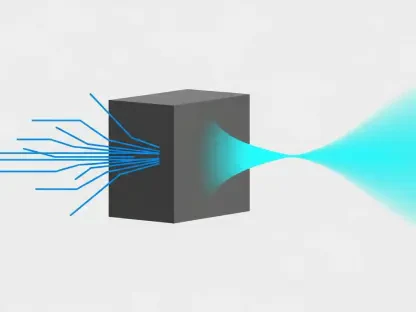The future of satellite navigation is being revolutionized by innovative techniques aimed at improving the orbit determination (OD) of large constellations of Low Earth Orbit (LEO) satellites. Traditional ground-based tracking stations, while a reliable backbone of satellite monitoring, struggle to meet the extensive and precise data requirements of these vast constellations. The emergence of spaceborne Global Navigation Satellite System (GNSS) receivers offers a promising alternative, yet current methodologies fall short when it comes to achieving the necessary computational efficiency and accuracy. This shortcoming has catalyzed the development of advanced OD techniques that could dramatically transform how we manage and operate LEO satellite constellations.
The Need for Advanced OD Techniques
Large LEO constellations require precise and efficient OD methods to ensure optimal performance and operational stability. Ground-based tracking stations suffer from limited capacity, making it increasingly challenging to handle the vast amounts of data needed for accurate monitoring of numerous satellites. Although the integration of spaceborne GNSS receivers has shown significant potential, there remains an undeniable need for advanced techniques that can comprehensively address the twin challenges of computational efficiency and accuracy. Recognizing this critical need, researchers from the Xi’an Research Institute of Surveying and Mapping, in collaboration with the State Key Laboratory of Spatial Datum, have spearheaded groundbreaking advances in autonomous OD of large LEO satellite constellations.
The research team has introduced a suite of novel methods that leverage GNSS observations in conjunction with inter-satellite ranging (ISL) to enhance both accuracy and computational efficiency. This development is vital for satellite operations encompassing communication, remote sensing, and navigation augmentation. By integrating GNSS data with ISL range measurements, these techniques provide the precision necessary to manage the increasing complexity and scale of LEO satellite constellations. This innovative approach addresses the critical challenges facing satellite navigation, enabling the seamless operation of large constellations with heightened accuracy and efficiency.
Innovative OD Strategies
One of the key contributions of this research lies in the presentation of three pioneering autonomous OD strategies, each meticulously designed to refine orbit parameters and boost accuracy without imposing a heavy computational load. The first strategy merges GNSS data with ISL range measurements, effectively fortifying orbital parameters and ensuring heightened accuracy. This integration significantly improves the precision of orbit determination, providing a robust foundation for satellite navigation and operations.
The second strategy takes a different approach by using ISL ranges as constraints to enhance accuracy. This method allows for improved precision without a corresponding increase in computational demands, making it an efficient solution for managing large LEO constellations. By leveraging ISL ranges as constraints, the technique ensures that the enhanced accuracy is achieved in a computationally efficient manner, addressing one of the primary challenges in satellite navigation.
The third and perhaps most adaptive method dynamically modifies the covariance matrix of orbit predictions to counteract errors introduced by irregularities in the dynamic model. This adaptive approach is guided by an adaptive factor, which effectively regulates errors stemming from anomalies in the dynamic model. By continuously adjusting the covariance matrix, this method ensures that the orbit determination remains robust and precise, even in the face of unpredictable dynamic irregularities, marking a significant advancement in OD techniques.
Simulation Success and Practical Implications
The efficacy of these innovative OD strategies has been demonstrated through rigorous simulations, showcasing remarkable improvements in both OD accuracy and efficiency. Notably, the root mean square error (RMSE) of position estimates decreased significantly, achieving a precision as fine as 11.34 centimeters when dynamic models were integrated with ISL ranges. This impressive reduction in RMSE underscores the potential of these methods to deliver unrivaled accuracy in satellite navigation.
In addition to accuracy gains, simulations highlighted the potential for parallelizing estimation processes for individual satellites. This parallelization substantially mitigates the computational burden, presenting a scalable and efficient solution for managing large satellite constellations. The ability to parallelize these processes ensures that the computational demands remain manageable, even as the number of satellites in a constellation continues to grow.
Dr. Yuanxi Yang, a leading expert in satellite navigation and a contributing author of the study, has underscored the practical significance of these stepwise autonomous OD methods. Dr. Yang emphasized that the integration of GNSS observations with ISL ranging achieves unprecedented precision and efficiency in OD. This advancement marks a crucial step forward in overcoming the traditional computational and accuracy challenges associated with the extensive numbers of LEO satellites, paving the way for more efficient and accurate satellite operations.
Broader Implications for Satellite Operations
The broader implications of this research are profound and far-reaching, with enhanced OD techniques offering scalable solutions poised to elevate the operational efficiency of sizable LEO constellations. Improved OD is critical for ensuring more accurate satellite communication, remote sensing, and navigation augmentation, all of which become increasingly essential as the number and complexity of satellite constellations continue to grow. These sophisticated methods promise to maintain precise orbit control, unlocking immense potential for global navigation, environmental monitoring, and various other satellite-based applications.
Notably, this novel approach to orbit determination not only addresses the limitations inherent in existing technology but also paves the way for more robust and precise satellite operations. The integration of advanced OD techniques ensures that large constellations can be managed with the requisite accuracy and computational efficiency. This is especially crucial as satellite constellations expand, demanding innovative solutions to maintain operational effectiveness and precision.
Future Prospects and Technological Advancements
The future of satellite navigation is undergoing a transformation through new techniques aimed at enhancing orbit determination (OD) for large constellations of Low Earth Orbit (LEO) satellites. Traditional ground-based tracking stations, while dependable, struggle to fulfill the extensive and precise data needs required by these large satellite groups. The introduction of spaceborne Global Navigation Satellite System (GNSS) receivers offers a viable alternative, but current methods are not sufficiently efficient or accurate. This limitation has spurred the creation of advanced OD techniques, which have the potential to significantly reshape the management and operation of LEO satellite constellations. These innovations are expected to overcome existing challenges and bring about significant improvements in both computational efficiency and accuracy. As a result, the entire landscape of satellite navigation and monitoring could be vastly improved, ensuring that future satellite missions are more reliable and effective than ever before.









